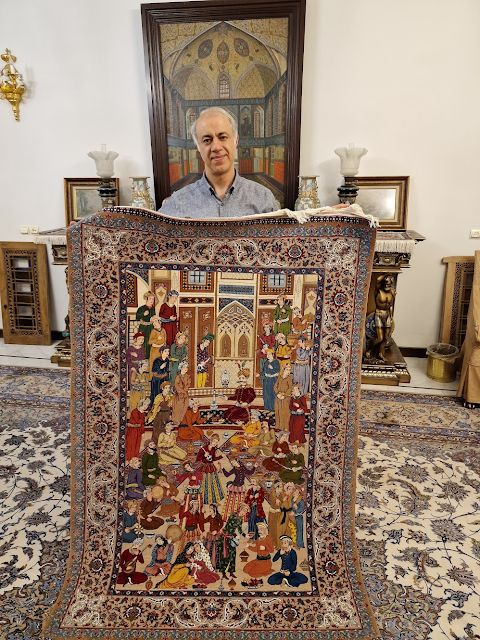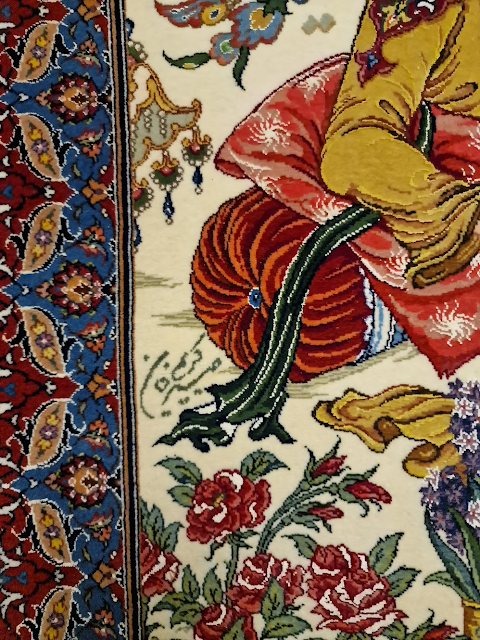A Glimpse into Grandmaster Karim Seirafian's Rug Workshop, March 2024
Hamed Sanei, Aarhus, Denmark, 2024
I visited Grandmaster Karim Seirafian in his Isfahan home in late March 2024 to discuss his latest works and the overall landscape of artisan Persian rug production. The main topic we discussed was in relation to my previous article: the direction of the Seirafian workshop as a whole and what constitutes art given the reality of new technologies that can infringe on the creative aspect of this work. Master Karim continues to lead the art of Persian rug weaving in Iran. His rugs, if one can ever find them in the market, fetch the highest value among all recently produced rugs in Iran, and even among most antique masterpieces, with exceptions, of course. The question might be why. It is not difficult to see why, because of his incredible obsession with excellence. There are several factors that he focuses on. One is the uniqueness of his creations. He only produces a handful of each, sometimes even just two, keeping one in his own archive and one for sale. Given the multi-year time needed to make his masterpieces, it is hard to imagine these rugs will ever be reproduced under his mastership. Aside from the uniqueness of his rugs, his strict adherence to traditional means of rug making—the methods he employs from beginning to end—are not much different from the time these masterpieces were produced in the royal workshops of the Safavid kings in the 16th and 17th centuries in Isfahan. This is perhaps the most important factor for the value of Karim Seirafian rugs. The next time you visit the great rugs of Safavid in the Victoria and Albert Museum or the Metropolitan Museum, you will have a better appreciation for the masterpieces coming from Karim Seirafian's workshop.
Another aspect of Karim’s rugs is his unbelievable obsession with the geometry of his rugs. They are executed in such a way that one cannot see millimeters of deviation from the planned symmetry. This is why Karim’s rugs are often referred to as the Patek Philippe of rug weaving. Combinations of spectacular designs, organic/artisan materials and production processes, and breathtaking execution make his rugs both an artistic masterpiece and an engineering marvel.
I was fortunate to see some of his latest masterpieces. Among those, a spectacular pair of paisley designs that were the result of years of restoration of lost designs of both the border and the center field by Grandmaster Ahmad Archang. The restoration painstakingly follows the exact pen of the master Archang, faithfully keeping the greatness of the design by Isfahan’s finest designer of all time. While a different and smaller version of this pair has been made before, this pair was larger and quite different in details. And in Karim’s rugs, the devil is always in the details. The colors are numerous but elegant so they don’t detract from the elegance of the design. This pair was my favorite of all the rugs I saw. It always amazes me how the classic Seirafian red and beige colors could bring so much beauty and elegance into the room.
The other rug from his private collection was a breathtaking flower and bird (gol-o-bolbol) classic. This is Karim’s interpretation of Haj Mosvar’s classic design with the same color composition that was once made by his late father and possibly grandfather. There are only a couple of examples of this composition existing in private collections. This rug, if ever becomes available for sale, is for the hardcore fans of gol-o-bolbol design and Haj Mosvar’s classic Seirafian with breathtaking execution by Master Karim.
The third rug was the scene of Safavid Royal Court celebration, which is designed by the grandmaster Haj Mosvar, inspired by a mural from the Safavid Chehel Sotoun palace in Isfahan. Collectors may have seen this design produced by Karim’s father, Grandmaster Haj Sadegh Seirafian. However, this is a different beast. The 47 persons depicted in the rug, each have completely different colors and designs of outfits. The color variations are incredible, perhaps over a hundred colors. The execution is absolutely stunning. There are only less than 5 of this rug made in different variations. This is the one in Master Karim’s private collection, which I had the pleasure of seeing. This rug is for the finest connoisseurs and collectors.
Since I met Master Karim during the Norooz festivity, he showed me a beautiful, charming rug designed by Master Mehrdad Sadri, depicting a traditional Qajar style miniature depiction of Haft Seen and Norooz, with modern touches in imagery of the male and female characters in the rug. This rug is in a landscape format and was a beautiful wall piece from his private collection.
I was also privy to several incredible masterpieces that I'll let the pictures speak for themselves. One was a classic Eslimi design in green, but not from Archang. This small rug was gorgeous. The green and cochineal red made a magical composition. The other rug was a very new, never-before-produced, original masterpiece of Grandmaster Javad Rostam Shirazi's design. Rostam Shirazi rugs are the exact opposite of Archang. Archang is about calm, peace, and tranquility, while Rostam rugs are energetic and have an inherent dynamism and movement to them. This rug has spectacular color diversity and is another rare masterpiece.
Finally, I'll let you see pieces of two grand rugs in Master Karim’s collection without saying much about them as promised. Enjoy!
Hamed Sanei, March 2024, Isfahan, Iran











































